Week 4: Who funds voluntary and community organisations?
Use 'Print preview' to check the number of pages and printer settings.
Print functionality varies between browsers.
Printable page generated Monday, 29 April 2024, 12:50 PM
Week 4: Who funds voluntary and community organisations?
Introduction
Organisations need resources to grow and develop, as well as to provide services and conduct different activities. For many voluntary organisations, securing funding and other resources is a constant challenge. Last week you explored the monetary value and contribution of the voluntary sector. This week you will learn where funding for voluntary organisations comes from.
Every voluntary organisation needs resources in order to fulfil its mission. ‘Resourcing’ organisations refers primarily to money, as this is needed to buy other resources like staff, premises and materials. However, some resources come in kind, such as volunteers, loans of staff or gifts of refurbished office furnishings. Most organisations will be reliant on different sources of funding, including government contracts, grants, donations and income from their own trading activities or investments.
This week you will find out about the different types of funding available to voluntary organisations and the degree of freedom they have in how to spend this money. You will explore who funds voluntary organisations: the funders can be public, private or other voluntary organisations, as well as individuals. You will also explore what issues might arise if funding is cut or if organisations rely too much on one source of funding.
You can also attempt the first compulsory badge quiz this week.
In the following video, the course author, Julie Charlesworth, introduces you to Week 4.
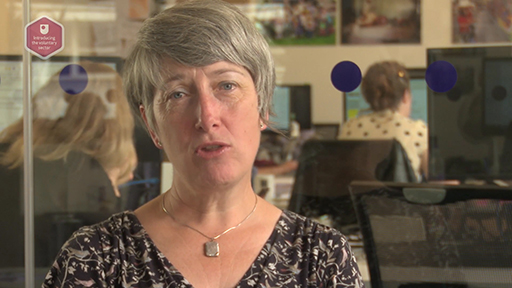
Transcript
By the end of this week, you should be able to:
- outline the different types of funding organisations in the voluntary sector
- understand the most important sources of funding
- describe the potential impact of government spending cuts on voluntary sector income
- find the information you need about funding in the voluntary sector.
1 What is funding?

Cartoon image of a group of people holding placards. The placards read (from left to right): Support us! Give. We need your help! Donate.
If you are involved with a very small organisation you may already have a good idea of how your organisation is funded and where the money comes from. You might have direct experience of running fundraising events or writing bids for funding from government or grant making trusts. Even if you’re not currently working in the voluntary sector or volunteering, you have probably seen people shaking their collecting tins or attended events run by organisations trying to raise money. In bigger organisations it may not always be so apparent where the funding comes from. You may know how the project you work on or support is funded but not be sure how the money is raised for everything the organisation does.
Although exploring ‘how to do’ fundraising is beyond the scope of this week’s study, it is useful to bear this in mind to provide a context for the rest of this week. There are many different methods that organisations might use to raise funds, such as street collections, small local events as well as national ones (e.g. Comic Relief or Children in Need television nights), sponsored runs, crowd funding, national campaigns for donations by text, phone, online, charity shops selling donated items as well as the organisation’s own products, and so on.
Some of these methods might generate only small total sums but for a small organisation these might be vital to their survival. Organisations may also raise funds through bidding for contracts to run services or by applying for grants but these are perhaps less visible outside the organisation – unless they are successful of course.
Activity 1 Out of the Blue
Read the following example of fundraising by Helen & Douglas House (H&DH), an Oxford-based organisation that cares for terminally ill children, young adults and their families. ‘Out of the Blue’, a group of singers from Oxford University, released a single in 2014, Hips Don’t Lie – Charity Single – Shakira – Out of the Blue, with all the profits going to the charity.
Out of the Blue Shakira medley
The fantastic Out of the Blue have recorded a medley of Shakira songs and all proceeds from the sale of the single come to H&DH, supporting hospice care for children and young adults.
We have been amazed by the popularity of the video, after Shakira herself posted it to her Facebook page, and sent a Twitter message to the Out of the Blue boys! Hundreds of thousands of people have watched the clip, so please watch and click through to buy the single, & support H&DH!
Now consider the following questions:
The charity single eventually raised £10,000.
- How significant is that sum of money for an organisation that had an income of £10.41 million in 2014?
- Why do you think it is important for voluntary organisations to get involved with this type of activity?
Comment
The sum of £10,000 is obviously a very small amount for this organisation – around 0.1% of their total income. Although you do not have all the details here, it is possible that H&DH do not have to get very involved with the singles – it is probably the group’s choice to make the singles and donate the money. Therefore receiving £10,000 for minimal effort is worth doing.
It is all good publicity for H&DH (and Out of the Blue): their cause was probably brought to the attention of people who were unaware of them before. The organisation would hope to gain more donations and also new volunteers from this. The organisation has 220 employees but 1250 volunteers, so volunteering is important to them.
Out of the Blue have a strong Oxford identity. Therefore, the charity (although Oxford-based it also operates across southern England and parts of the Midlands) is also making a local connection and hoping to draw on more local support. Furthermore, H&DH rely almost entirely on donations. This illustrates that seemingly small initiatives like this have a wider application than funding, by potentially generating publicity, interest and more donations, and all therefore adding to the picture of sustainable resources for organisations.
For some voluntary organisations, however, receiving £10,000 could be significant funding, which enables them to keep going for another year. As you will see later this week, income from individuals forms the largest proportion of funding for every size of organisation (NCVO, 2015).
Many organisations try to obtain resources from different funders so they are not reliant on just one source. This has become particularly important in recent years as government funding to voluntary organisations has been cut. However, having different sources of funding creates challenges: in addition to all the work needed to apply for funding, numerous external relationships then have to be managed, as well as completing all the reports and complying with any monitoring required, when funding is through contracts and grants.
2 Looking at funding through annual reports
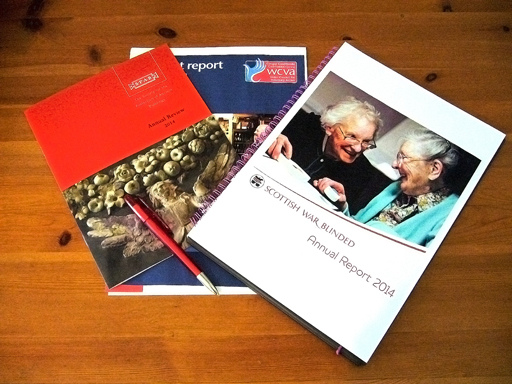
One key method of finding out about funding is to look at an organisation’s annual report, which (if it is a charity) by law it has to lodge every year with the appropriate charity regulator for the part of the UK in which the organisation operates. Annual reports generally highlight the organisation’s main activities, achievements and challenges for the year, as well as information on funding received from grants, contracts, donations and income from investment and trading activities. Annual reports are useful ways to inform stakeholders about the organisation’s work. The following two activities are based on using annual reports to focus on sources of funding.
Activity 2 How many funders?
In this activity you will look briefly at one organisation to get a sense of the myriad funding possibilities and relationships. The organisation is Belfast and Lisburn Women’s Aid (2016), which provides support, help and emergency accommodation for women and children affected by domestic violence.
The following extract from their annual report lists the organisation’s funders for 2013.
THANK YOU TO ALL OUR FUNDERS
Thank you to our partner agencies listed below and to all the dedicated individuals, organisations and companies who supported our work against Domestic Violence so generously during the year.
- Belfast City Council Community Safety
- Belfast Health & Social Care Trust
- Big Lottery Fund – Improving Futures
- Big Lottery Fund – Reaching out – Connecting with Older People
- Children in Need
- Comic Relief
- Department of Education – Early Years Fund
- Department of Justice
- DHSS&PS
- Down Safer Communities Partnership
- East Belfast Policing and Community Safety Partnership
- Health & Social Care Board
- Lisburn Policing and Community Safety Partnership
- Northern Ireland Housing Executive
- Northern Ireland Housing Executive – Supporting People
- Nutricia Ltd
- Police Service Northern Ireland
- Probation Board Northern Ireland
- Public Health Agency
- South Belfast Policing and Community Safety Partnership
- South Eastern Health & Social Care Trust
- Tesco
- Read through the list and for each funder note whether they are public, private or voluntary sector.
- Which funder is most prominent? If you do not recognise the names of the organisations, you could quickly search for them online.
- What might be missing from this list of funders?
Comment
| Public sector | Private sector | Voluntary sector |
|---|---|---|
| Various community safety partnerships | Nutricia Ltd | Big Lottery Fund |
| Health & Social Care Trust | Tesco | Children in Need |
| Department of Education | Comic Relief | |
| Department of Justice | ||
| DHSS&PS | ||
| Health and Social Care Board | ||
| Northern Ireland Housing Executive | ||
| Police Service | ||
| Probation Board | ||
| Public Health Agency |
Were you surprised by how many funders there were? This is partly due to the nature of this organisation: it spans policing, community safety, housing, education and health issues, therefore one source of funding would not cover everything the organisation seeks to achieve. Many organisations, such as women’s aid groups and others in health and social care, often work in
What is missing from this list are the names of individuals who might have donated money. Much fundraising results in small amounts, which together can add up to a significant sum and contribute to the running of organisations. Much of this would also be anonymous giving.
You might also want to think about the challenges of managing these relationships and what different funders might give money for – is it for one-off or long-term activities? These are important issues to be discussed further this week.
2.1 Further sources of funding information
Annual reports are usually available on organisations’ websites – as in the example in Activity 2. As mentioned earlier, another way to find financial information on voluntary organisations is through charity regulator websites. The list below shows some sources of information within the UK.
- Charity Commission (England and Wales) (UK Government, n.d.)
- Charity Commission (Northern Ireland) (2014)
- Guidestar UK (England and Wales) (2011)
- Scottish Charity Regulator (n.d.).
Some small organisations do not have to submit returns, but it is still likely that they will produce a financial report for their members and other stakeholders.
Activity 3 How much funding?
In this activity you will look at the financial information from two annual reports: the first is for Belfast and Lisburn Women’s Aid and is presented below.
| Incoming resources 2013/14 | £ | % |
|---|---|---|
| Supporting people | 863,073 | 39 |
| Floating support | 546,174 | 25 |
| Trusts | 160,254 | 7 |
| Grants | 397,280 | 18 |
| Housing management | 150,330 | 7 |
| Donations | 38,685 | 2 |
| Investment income | 35,587 | 2 |
| Rental income | 12,744 | 1 |
| Utilities income | 4548 | |
| Training | 6769 | |
| 2,215,444 | 100 |
Footnotes
Note: Floating support and supporting people are housing support programmes provided by the Northern Ireland Housing Executive, and also funded by health and social care and probation services.The second set of financial information you will seek out for yourself. Look for the annual financial report for an organisation you are familiar with or interested in. You could search the organisation’s own website or one of the regulator websites listed above to find the relevant information about incoming resources.
Look at the income for the two organisations and then answer the following questions:
- What are the different sources of funding that the organisations have?
- What are the implications of these sources for them?
Comment
For Belfast and Lisburn Women’s Aid, you already know from Activity 2 which organisations funded them during this time period. What this information now gives you is the form that the funding took: trusts, grants, donations, as well as investment and other income.
What is less clear from these accounts is who is providing the grants, for example. Also, ‘trust’ can refer to an organisation providing funding, so in these accounts ‘trusts’ probably means funding from organisations that are trusts.
The biggest sums are from supporting people and floating support, which are public sector programmes. Many voluntary organisations, like Women’s Aid, are also able to raise money from investments and rental income. General donations are important, although for this organisation they are just 2% of the total. You will look at these different sources in more detail in the next section.
Therefore, it seems that this organisation is primarily dependent on government funding, which could create problems for its projects, activities and general operation if there are cutbacks in public spending. In fact, in their report (p. 4) they highlight:
Our challenges ahead remain sustaining services amidst government cuts and imminent procurement and tendering processes.
In your own example report, the organisation might have distinguished between restricted and unrestricted funding. Restricted funding means that it can only be spent on the specific project for which the money was intended and the organisation has little flexibility in how this may be used. An example of this can be seen in the annual report of the Women’s Aid Federation in Northern Ireland (2014, p. 74). This is an overarching group supporting women and children who are victims of domestic violence. Their unrestricted funds were £80,576 and restricted funds £761,309 – which is quite a difference.
For Belfast and Lisburn Women’s Aid, although the main accounts do not distinguish between restricted and unrestricted funding, they mention in their written review of the year (p. 2) that they received funding from the Big Lottery to make one of their centres more energy efficient. This money would of course be restricted to this particular project and they would inevitably have to provide feedback on how it has been spent and the success of the project.
If you are new to looking for and making sense of financial information, hopefully it was not too difficult. Getting to grips with annual reports is an important skill but also increases your knowledge about sources of funding and the possible dependence – and therefore vulnerability – of organisations on particular sources.
Organisations are required to make this type of financial information freely available in order to be more
3 Income from individuals

There are really only four main sources of funding for the voluntary sector:
- individuals
- foundations
- public sector
- private sector.
Overall, individuals and the public sector are the biggest sources of income. In terms of how funding is actually given to voluntary organisations, it is generally through three main methods:
- donations
- grants
- contracts.
There are various sources of information about ‘giving’ to the voluntary sector, in particular the NCVO’s UK Civil Society Almanac 2015 and the annual Charities Aid Foundation’s (CAF) UK Giving Survey (2015). The information in this section is primarily from the NCVO (2015).
As noted earlier, income from individuals provides the largest proportion of income for the voluntary sector – 46% of total income. However, it is most important to the smallest organisations – those classified as micro and small – where it forms 56% of their total income. For the largest organisations – major – it is 44% of their income. Within the sector, some organisations such as parent-teacher associations are very dependent on income from individuals, where it forms 88% of their income.
Donations include voluntary income (donations and legacies) and earned income (sales of products and fees for events, etc.). Donations and legacies account for 37% of the total income from individuals. In terms of earned income, the majority of money comes from charitable trading (fees, training courses, admission charges or membership). The main causes supported by individuals are medical research, children and young people, hospitals and hospices.
Donations can be restricted or unrestricted but organisations need a balance of both, given that core costs need to be covered. Regular giving is valued by organisations as it gives some predictability. Donations are not necessarily restricted to individuals – organisations also donate money for specific projects or make one-off donations.
Activity 4 How to choose a charity
Imagine you have £100 you want to give to a charity. Which charity would you choose and why?
In the box below is a list to guide your thinking. Next to each item type in a number from 1 to 4 to rank the reasons in their order of importance to you.
1 = the most important reason
2 = important reason
3 = not very important reason
4 = unimportant
Comment
You might, of course, have had other reasons or ideas that did not fit with the list provided. The choice of reasons in this list was based on research by Beth Breeze (2013). She conducted a study with 60 donors and asked them about how they decided which charities to support and why. Breeze concluded that ‘donors often support organisations that promote their own preferences, that help people they feel some affinity with, and that support causes that relate to their own life experiences’ (p. 180). She also found that people did not do much research themselves on which causes to support and were often influenced by the latest campaign on television and in newspapers or what came in the post.
Other reasons might be that you already volunteer or support the organisation, or that the organisation works locally. It is certainly difficult at times to choose between organisations: I support two charities on a regular basis because they did a ‘hard sell’ on me in the street. They fit very well with everything I believe in but of course there are many more similar charities that I could have chosen.
4 Income from government
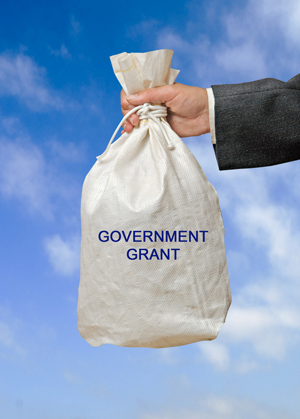
The second biggest source of funding for many voluntary organisations is from government although, as you saw earlier, some organisations such as Helen & Douglas House receive no income outside of donations. Income from government is either voluntary income (grants) or earned income (contracts or fees). Local government is the main provider of this funding but central government, the European Union and NHS trusts provide large sums too.
According to NCVO (2015), the voluntary sector received £13.3 billion in 2012/13, most of which was earned through contracts or fees. The NCVO data show that more than a third of the funding for major organisations comes from government, whereas for micro and small organisations, it is 16%. The reasons why the smallest organisations have less government funding are two-fold: first, small organisations may not actually need government funding if they are operating in fields that are more locally or hobby-based; second, micro and small organisations may not have the resources or knowledge required to take part in lengthy and complex negotiations and writing applications.
At the time of writing in 2015, a key feature of UK government funding is that it is on the decline: since 2009/10 income has fallen every year and this is in line with government cuts across public spending. This is likely to continue to do so. Furthermore, there is an increasing shift from grants to contracts, making funding more restricted.
The differences between grants and contracts
A
A
Activity 5 Grants versus contracts
Think about the following questions and make some notes:
- What do you think are the advantages and disadvantages of grants and contracts?
- What would be your preference if you were involved with fundraising in a voluntary organisation?
Comment
The advantage of grants and contracts at a simplistic level is that they both provide funding, which is what organisations need to function.
The disadvantages common to both are the amount of work involved in writing applications for grants or tenders for contracts.
The main advantage of a grant over a contract is that the organisation decides what to apply for and how it will use the money. Some grants will be monitored and evaluated, so they are not effort-free once awarded.
One advantage of a contract is that it may enable an organisation to provide a vital service. However, contracts do involve a considerable amount of work through the tendering process and the organisation has to ensure it is able to deliver according to the tightly specified terms of the contract. A disadvantage is that when the contract comes to an end, an organisation may have to end the service and possibly make staff redundant or transfer them to the new contract holder.
Therefore, if you were involved in fundraising, you would need to think carefully about the advantages and disadvantages created by these types of funding. The context is also important: one type might be more common or appropriate in your organisation and, of course, it depends what your organisation needs the money for – for example, a one-off project or something it wants to run long term.
One concern for voluntary organisations is that a heavy reliance on government contracts or other major funders might compromise the organisation’s independence and its ability to campaign. The Panel on the Independence of the Voluntary Sector (n.d.) was established in 2011 (with a particular focus on England) to investigate concerns about independence. It has published various reports exploring risks and challenges to the voluntary sector.
4.1 Social value
An increasingly important aspect of contracts in the UK is that they require organisations to specify their ‘social value’. Compact Voice, talking about the English experience, describes social value as:
the
additional value created in the delivery of a service contract which has a wider community or public benefit – this extends beyond the social value delivered as part of the primary contract activity. For example, a homelessness organisation funded to provide hostel space for the homeless may create additional value by providing routes into employment and training for its service users.This is a move away from awarding contracts based on lowest cost, and is of particular significance given the increasing pressure on public spending.
In theory, this move might enable voluntary organisations to win more contracts. But this needs to be weighed against the restrictions, and the additional workload and effort of contracts, as well as concerns about the loss of independence for the organisation.
5 Income from other sources

Voluntary organisations also receive funding from other parts of the voluntary sector, private sector organisations, the National Lottery and from income earned on investments.
You have already read about donations by individuals but donations are also given by private sector organisations. For example, every Waitrose branch gives £1000 each month to three local causes and since the scheme started in 2008 the company has donated £14 million. Waitrose gives the money but customers choose which one of the three local causes receives the most by allocating tokens in a box (Waitrose, 2015).
Although each organisation receives only a small amount, the organisations themselves are usually small too and a few hundred pounds can make a difference.
Activity 6 Family foundation philanthropy
Watch this video from 2011 in which Professor Cathy Pharoah from Cass Business School and Charles Keidan, Director of Pears Foundation, talk about philanthropic giving by
Make notes on the key features of family foundations.
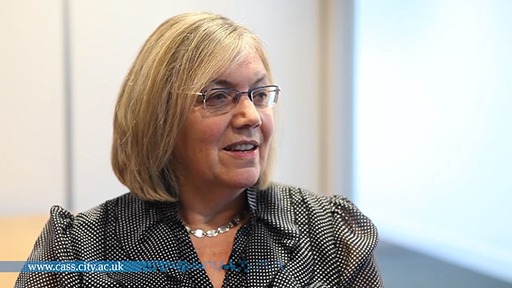
Transcript
Comment
Family foundations are charitable trusts but tend to have members of one particular family on the boards of trustees. They employ professional staff so that they can improve the effectiveness of their giving strategies. Family foundations appear to be an important source of funding, given that the amounts they give are increasing, whereas individual and corporate donations have slowed down. Keidan argues that family foundations are increasingly important in helping difficult issues that require a longer-term approach.
So far this week you have seen that there are consequences for voluntary organisations in terms of funders’ expectations of a return on their contribution, depending on which kind of funding the organisation pursues. Essentially, the more specific the purpose for which funding is given, the greater the degree of control and accountability the funder will usually expect. Many sources of funding come with ‘strings attached’ that may place limitations on an organisation’s freedom of action. So there may be trade-offs that have to be made when deciding whether to accept this funding. Organisations need to decide whether the trade-off will compromise their mission too much. This is a decision that needs to be taken consciously rather than by default.
6 Funding challenges
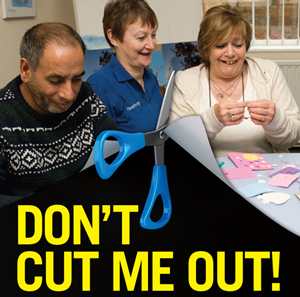
Headway poster showing a pair of scissors cutting through the image of three people. The text on it reads: Don’t cut me out!
You saw earlier that UK government funding to voluntary organisations decreased in recent years as part of the review of public spending in 2010. The impact of this has been felt particularly in England, although many charities across the UK have had to cut jobs and services. In the next activity you will look at a case study of a voluntary organisation that has had to manage cuts to its funding.
Activity 7 Headway
Headway (2015) states that it aims to ‘promote understanding of all aspects of brain injury and provide information, support and services to survivors, their families and carers’. The organisation ran a campaign in 2014 to draw attention to how their service users were being affected by funding cuts.
Watch the following video about Headway in the West Midlands. Make notes on how the organisation is experiencing cuts to its funding and how its service users are affected.

Transcript
Comment
The news report initially focuses on an individual’s story, which makes the film hard-hitting but also explains who the organisation is trying to help. One clear theme from the report is that it is not just cuts to Headway’s services that are important but also cuts across public services. So, even if Headway can provide a service, someone whose benefit has been cut leaving them with no money for transport, or whose eligibility criteria for funding has changed, would not be able to access Headway’s service. The spokesperson also highlights how cutting one smaller service might lead to a bigger drain on health and social care services in the long term.
The video illustrates many of the issues highlighted this week around the complexities of different funding sources.
Now all that is left for you to complete this week is the first badge quiz.
7 This week’s quiz
Now it’s time to complete the Week 4 badge quiz. It is similar to previous quizzes, but this time, instead of answering five questions there will be fifteen.
Remember, this quiz counts towards your badge. If you’re not successful the first time, you can attempt the quiz again in 24 hours.
Open the quiz in a new tab or window (by holding ctrl [or cmd on a Mac] when you click the link).
8 Summary
Congratulations on reaching the end of Week 4 – you are now halfway through the course. This week has focused on an overview of the main sources of funding for voluntary organisations and some of the issues and challenges that may arise. You now have a basic knowledge and understanding of funding opportunities and challenges, which you could apply to further research on funders suitable for organisations you are particularly interested in.
There is more on the practicalities of doing fundraising in another free badged OpenLearn course, Working in the voluntary sector, which will be available in 2016.
In Week 4 you have learned about:
- the types of organisations that fund voluntary organisations
- how funding is given to voluntary organisations – as donations, grants and contracts
- what the differences are between restricted and unrestricted income
- how to use annual reports and websites to find information on funders and types of funding
- the challenges of having contracts with government to deliver services.
You are now half way through the course. The Open University would really appreciate your feedback and suggestions for future improvement in our optional end-of-course survey, which you will also have an opportunity to complete at the end of Week 8. Participation will be completely confidential and we will not pass on your details to others.
You can now go to Week 5.
References
Acknowledgements
Except for third party materials and otherwise stated (see terms and conditions), this content is made available under a Creative Commons Attribution-NonCommercial-ShareAlike 4.0 Licence.
The material acknowledged below is Proprietary and used under licence (not subject to Creative Commons Licence). For the avoidance of doubt: All third party videos credited below, and those which link you to Youtube for viewing, are not subject to Creative Commons licensing. Grateful acknowledgement is made to the following sources for permission to reproduce material in this unit:
Course image: © Katie Hetrick in Flickr https://creativecommons.org/ licenses/ by/ 2.0/.
Figure 1: Aysezqicmeli/shutterstock.com.
Figure 2: selection of covers from organisations annual reports including: Scottish War Blinded (2014).
Figure 3: Syda Productions/Shutterstock.com.
Figure 4: arka38/iStockphoto.com.
Figure 5: Photo of National Lottery logo image: Lucian Milasan/Shutterstock.com.
Figure 6: Headway poster, courtesy Headway https://www.headway.org.uk/.
Activity 2 and Activity 3: extracts from: http://belfastwomensaid.org.uk/ publications/ annual-report-2013. Courtesy: Belfast & Lisburn Women's Aid.
Activity 6 video: courtesy: Cass Business School, City University, London.
Activity 7 video: BBC West Midlands Today https://www.youtube.com/ watch?v=mX-p4USOrT4 © BBC 2014.
Some content from this week draws on material by Jill Mordaunt from B191 Working in Voluntary and Community Organisations.
Every effort has been made to contact copyright owners. If any have been inadvertently overlooked, the publishers will be pleased to make the necessary arrangements at the first opportunity.
Don’t miss out
If reading this text has inspired you to learn more, you may be interested in joining the millions of people who discover our free learning resources and qualifications by visiting The Open University – www.open.edu/ openlearn/ free-courses.
Copyright © 2015, The Open University.